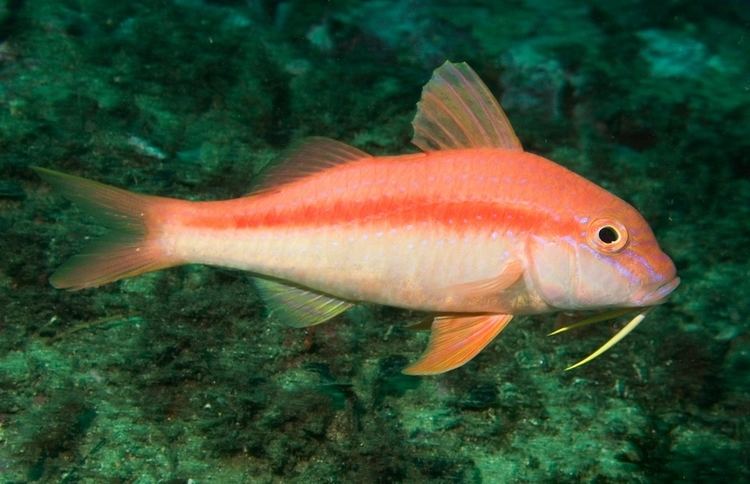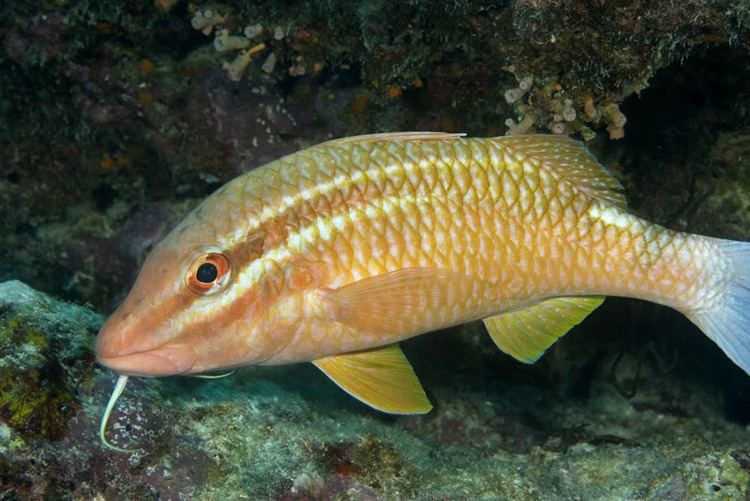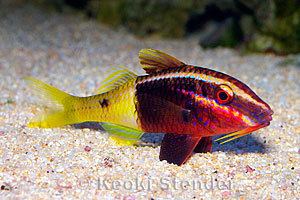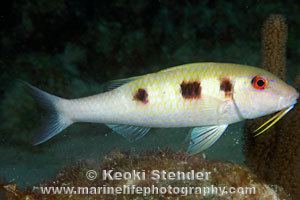Rank Family | Scientific name Mullidae Phylum Chordata | |
 | ||
Lower classifications | ||
Cape verde fish the fishipedia west african goatfish salmonete barbudo
The goatfishes are perciform fish of the family Mullidae. The family is also sometimes referred to as the red mullets, which also refers more narrowly to the genus Mullus.
Contents
- Cape verde fish the fishipedia west african goatfish salmonete barbudo
- Red goatfish and cinnabar goatfish bottom feeding in bali
- Description
- Distribution and habitat
- Ecology
- Mimicry
- Reproduction and life cycle
- Economical importance
- References

The family name and the English common name "mullet" name are derived from Latin mullus, the red mullet; but other than the red mullet and the striped red mullet or surmullet, the English word mullet generally refers to a different family of fish, the Mugilidae or grey mullets.

Red goatfish and cinnabar goatfish bottom feeding in bali
Description
Goatfishes are characterized by a pair of chin barbels, which contain chemosensory organs and are used to probe the sand or holes in the reef for food. Their bodies are deep and elongated, with forked tails and widely separated dorsal fins. The first dorsal fin has 6-8 spines; the second dorsal has one spine and 8-9 soft rays, shorter than anal fin. Spines in anal fin 1 or 2, with 5-8 soft rays. They have 24 vertebrae.

Many goatfishes are brightly colored. The largest species, the dash-and-dot goatfish (Parupeneus barberinus), grows to 60 cm in length; most species are less than half this size. Within the family are six genera and about eighty-six species.
Distribution and habitat

Goatfishes are distributed worldwide in tropical, subtropical and temperate waters. Goatfishes occur in a range of habitats. Most species are associated with the bottom of the littoral, but some species of Upeneus can be deep; for example the goatfish Upeneus davidaromi can be found to depths of 500 m. Tropical goatfishes live in association with coral reefs. Some species, such as the freckled goatfish (Upeneus tragula) enter estuaries and rivers, although not to any great extent.
Ecology

Goatfishes are tireless benthic feeders, using a pair of long chemosensory barbels ("whiskers") protruding from their chins to rifle through the sediments in search of prey. They feed on worms, crustaceans, molluscs and other small invertebrates. Other fish shadow the active goatfish, waiting patiently for any overlooked prey. For example, in Indonesia large schools of the l goldsaddle goatfish (Parupeneus cyclostomus) and moray eels hunting together. This behavior is known as shadow feeding or cooperative hunting. By day, many goatfishes will form large schools of inactive (non feeding) fish; these aggregates may contain both conspecifics and heterospecifics. For example, the yellowfin goatfish (Mulloidichthys vanicolensis) is often seen congregating with bluestripe snappers (Lutjanus kasmira). All goatfishes have the ability to change their coloration depending on their current activity. One notable example, the diurnal goldsaddle goatfish (Parupeneus cyclostomus) will change from a lemon-yellow to a pale cream whilst feeding.
Mimicry
Goatfishes have the ability to rapidly change color, and many species adopt a pale coloration when resting on the sand to blend with the background and become less visible to predators. These changes in color are reversible phenotypic changes and happen within seconds many times during the lifespan of an individual.
Two species of goatfishes, the mimic goatfish Mulloidichthys mimicus and Ayliffe's goatfish Mulloidichthys ayliffe have evolved to mimic the blue-striped snapper Lutjanus kasmira, with whom they often form schools. These are slow, genetic changes that have occurred during the evolution of goatfishes over many generations.
Reproduction and life cycle
Goatfishes are pelagic spawners; they release many buoyant eggs into the water which become part of the plankton. The eggs float freely with the currents until hatching. The larvae drift in oceania waters or in the outer shelf for a period of 4–8 weeks until they metamorphose and develop barbels. Soon thereafter most species take of bottom-feeding life-style, although other species remain in the open water as juveniles or feed on plankton. Juvenile goatfishes often prefer soft bottoms, in seagrass beds to mangroves. They change habitat preference as they develop, coinciding with changes in feeding habits, social behavior and the formation of association with other species. Most species reach reproductive maturity after one or two years.
Economical importance
Goatfish species are an important fishery in many areas of the world and some species are economically important. In ancient Rome until the end of the second century AD, two species of goatfish (Mullus barbatus and Mullus surmuletus) were highly sought-after and expensive, not as a delicacy, but for aesthetic pleasure, since the fish assume a variety of colors and shades also during death. Therefore, it was paramount to serve the fish live and let them die before the eyes of the guests.
